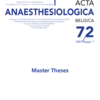How effective is an ultrasound-based imaging technique with automated guidance as an aid in performing spinal anesthesia in elective caesarean section patients? A prospective randomized controlled trial
Anesthesia; spinal; Cesarean section; ultra-sonography
Published online: Apr 21 2022
Abstract
Background: Ultrasound could potentially aid the procedure of neuraxial anesthesia by obtaining the needle entry site more reliably, thereby lowering the number of needle insertions and thus lowering the rate of complications. This single center prospective randomized trial evaluated the effectiveness of an ultrasound device with automated guidance as an aid in performing spinal anesthesia in pregnant patients undergoing an elective caesarean section (C-section).
Methods: Fifty-eight patients were included and randomized in one of both groups. The needle entry site was identified by a pre-procedure ultrasound in the study group or by a traditional landmark palpation technique in the control group. The primary outcome was first attempt success. Secondary outcomes were: number of needle passes, preparation time (time needed to identify needle insertion point, with or without the use of the device), needle insertion time (time interval from the initial needle insertion until the visualization of cerebrospinal fluid (CSF), total procedure time (sum of the preparation time and needle insertion time) and patient satisfaction. Sub-group analysis was performed on obese patients (body mass index ≥ 30 kg/m 2 ), on cases where residents or attending physicians performed the procedure.
Results: No significant difference in the rate of first attempt success was found among all patients, nor in the sub-group of obese patients, nor in the sub-groups of residents or attending physicians performing neuraxial anesthesia. No significant difference was found in the number of needle passes or patient satisfaction. Use of ultrasound resulted in a significantly longer preparation and total procedure time.
Conclusion: This study could not prove a significant advantage of using a pre-procedure ultrasound device when performing neuraxial anesthesia in elective C-section patients. The post-hoc study power appeared insufficient to draw any conclusions. Additional research is required to evaluate the clinical effectiveness of using a pre-procedure ultrasound when performing neuraxial anesthesia in pregnant patients.
